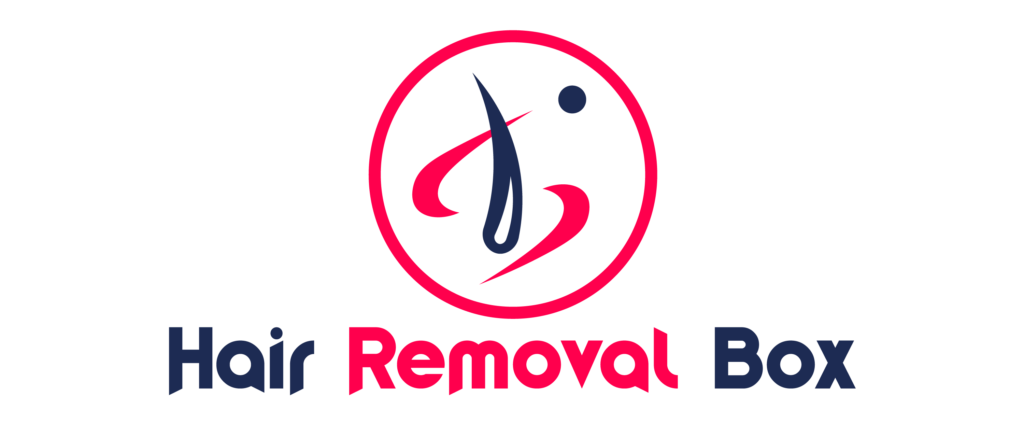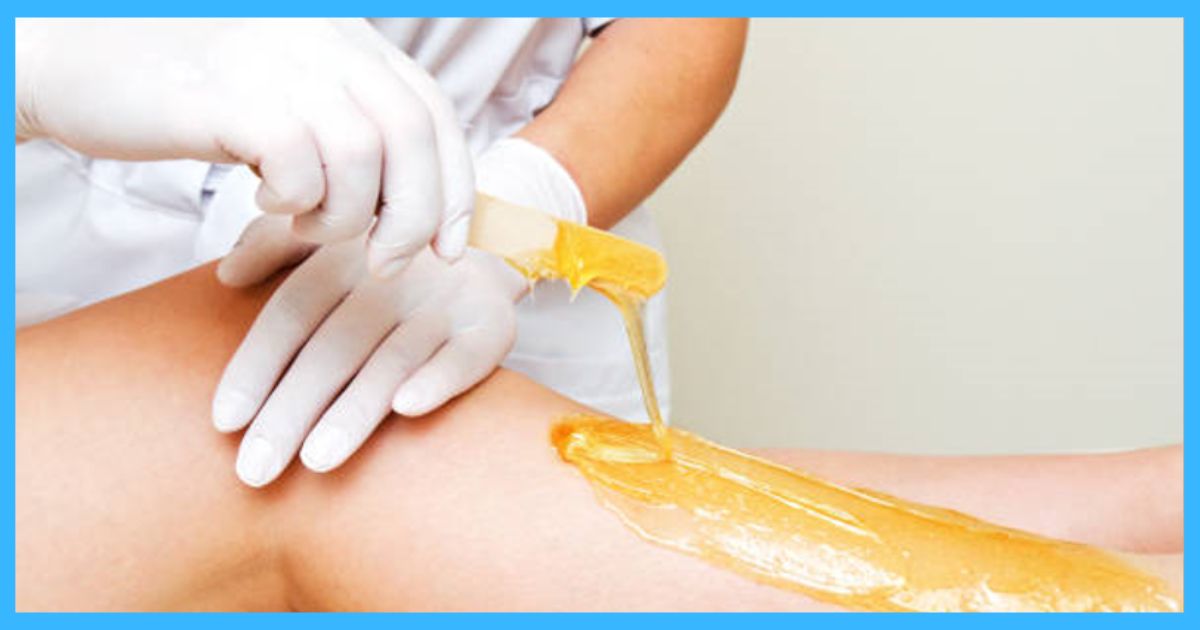You might have wondered: Can you wax after laser hair removal? The short answer is yes, but not right away. You must wait until your skin fully recovers from the laser treatment, which usually takes a few weeks.
However, I am here to discuss the safety of combining waxing and laser hair removal. Whether you are a veteran of hair removal techniques or just curious about your options, this post is for you.
Stick around as I explore this topic in simple terms, easy enough for anyone to follow.
Laser Hair Removal-Overviews
Many people use laser hair removal to get rid of unwanted hair over time. A laser, a directed beam of light, is used to target the colour of hair follicles. When the pigment takes in light, it turns into heat, which hurts the root and stops hair from growing back.
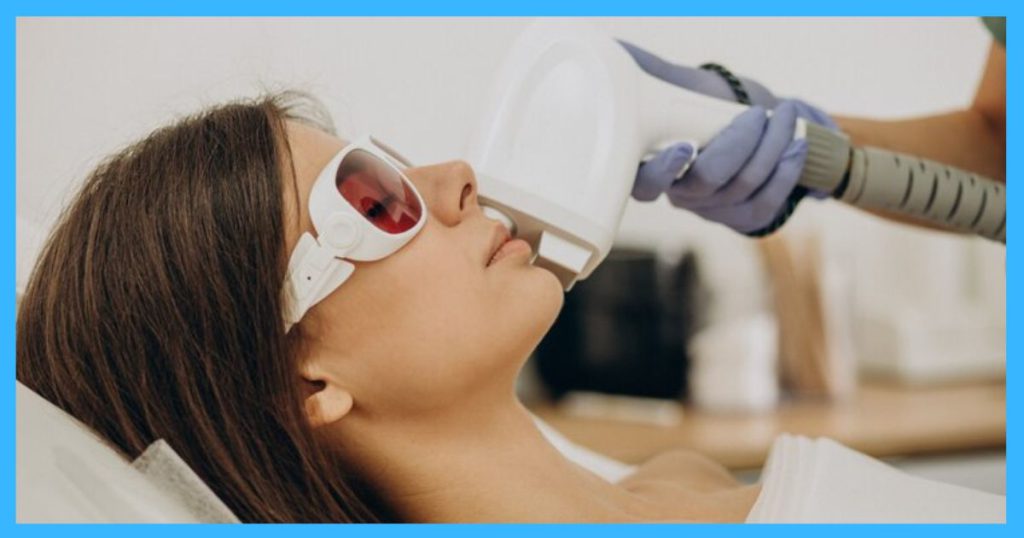
However, this is a simple explanation of how it works:
- Getting ready: The area to be treated will be cleaned before the process. A numbing cream may be used sometimes, especially if the area is sensitive.
- The Laser Tool: The tech uses a laser tool held in his hand. Their job is to set the laser to the correct settings for your hair and skin type.
- The Process: The laser sends out a concentrated ray of light that is taken in by the colour of the hair follicles below the skin’s surface. The light energy turns into heat, which hurts the hair cells.
- Post Treatment: Your skin may be red and swollen for the first few hours after the treatment. Gels or ice packs that cool the skin can help it feel better.
Why Do People Choose Laser Hair Removal?
There are different reasons why people choose laser hair removal:
- Long-Term Results: Results can last for months or even years; for some people, they’ll be permanent. It usually takes more than one practice.
- Precision: Lasers can safely target dark, thick hairs without hurting the skin around them.
- Speed: The laser’s pulses only last a few hundredths of a second, so it can treat many hairs simultaneously. Large areas, like the back or legs, might take up to an hour to treat, while small areas, like the upper lip, can be done in less than a minute.
Considerable Thinking About Laser Hair Removal
Even though laser hair removal works, here are some things to think about:
- Skin Type and Hair Color: If you have light skin and dark hair, you will probably get the best results from the laser because it works on the melanin (pigment) in the hair.
- Pain Factor: Some people may feel pain during the treatment, like a rubber band snapping against their skin.
- Needs Multiple Sessions: To get the best results, you need more than one session since you can only target hair that is actively growing.
Laser hair removal is a safe method to stop hair growth as long as it is done by a trained professional. If you’re considering getting this treatment, you should talk to a professional about the best way to do it for your hair and face.
The Basics of Waxing
Waxing is a popular method for removing unwanted hair from various body parts, such as the face, legs, arms, and bikini area. This method removes hair from the root, providing a longer-lasting result than shaving.
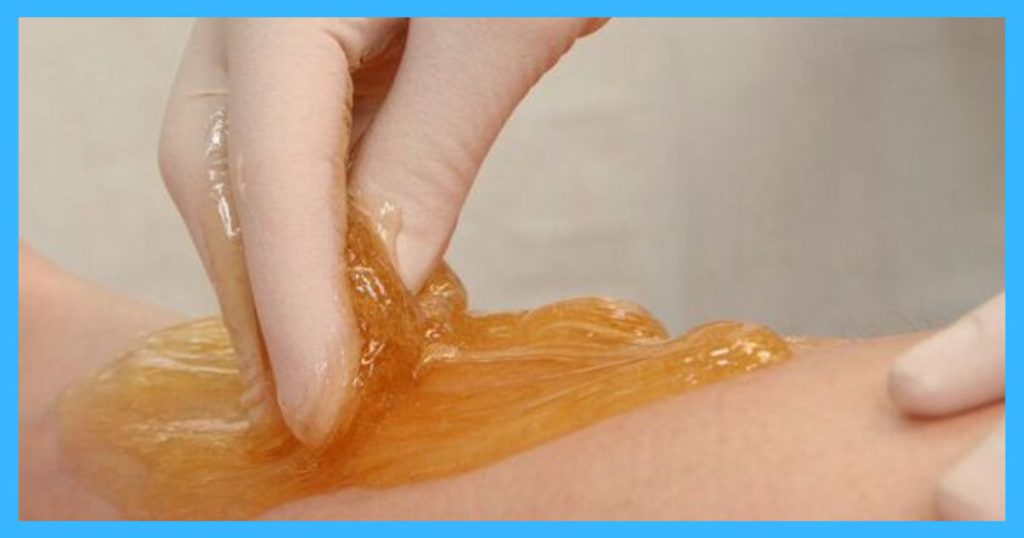
What you need to know about waxing before you try it and how it works are written below.
The Process of Waxing
- Preparation: First, the skin is cleaned. If desired, powder can be sprinkled on top to soak up any extra oil. Before the wax can fully grip the hair, it must be a certain length, usually about a quarter-inch.
- Application: Warm wax is spread over the hair, going in the growing direction. People don’t get burned because the temperature is kept at a good level.
- Removal: The wax is removed by pressing a strip of cloth or paper hard onto it. It is then quickly removed, going the opposite way hair grows. This movement pulls the hair out from the root.
- Care After Waxing: To soothe the skin after waxing and reduce redness and inflammation, lotions or oils may be used.
How to Wax Different Ways?
Wiping down with wax comes in two main types:
- Soft Wax: The thinnest layer of soft wax, which is also called “strip wax,” is put on and then removed with strips of paper or cloth. The legs and arms are good places to use it for bigger areas.
- Hard Wax: When you want to remove hard wax, you don’t need strips because it is thicker. When it cools, you can lift it off your skin after it dries. If you want to keep your bikini line or face safe, hard wax is better than soft wax because it is not as rough.
Benefits of Waxing
- Longevity: Depending on how fast your hair grows, the effects may last between 3 and 6 weeks.
- Exfoliation: The face is smoother after waxing because the hair and dead skin cells are removed.
- Regrowth of Thinner Hair: If you wax often, your hair may become thinner and less dense.
Considerations
Pain: Waxing can be painful, especially in awkward places, because it pulls hair out by the roots.
Skin Sensitivity: Redness, soreness, or small bumps on the skin may happen to some people after waxing.
Timing: If you’d rather not have hair, you’ll have to wait for your hair to grow to the correct length between sessions.
You can remove hair with wax if you want a helpful solution that will last a while. If you want to avoid pain and get the best results, taking care of your face properly before and after waxing is essential.
Talking to a professional before your first waxing session might be a good idea if you have sensitive skin or other worries.
Can You Wax After Laser Hair Removal?
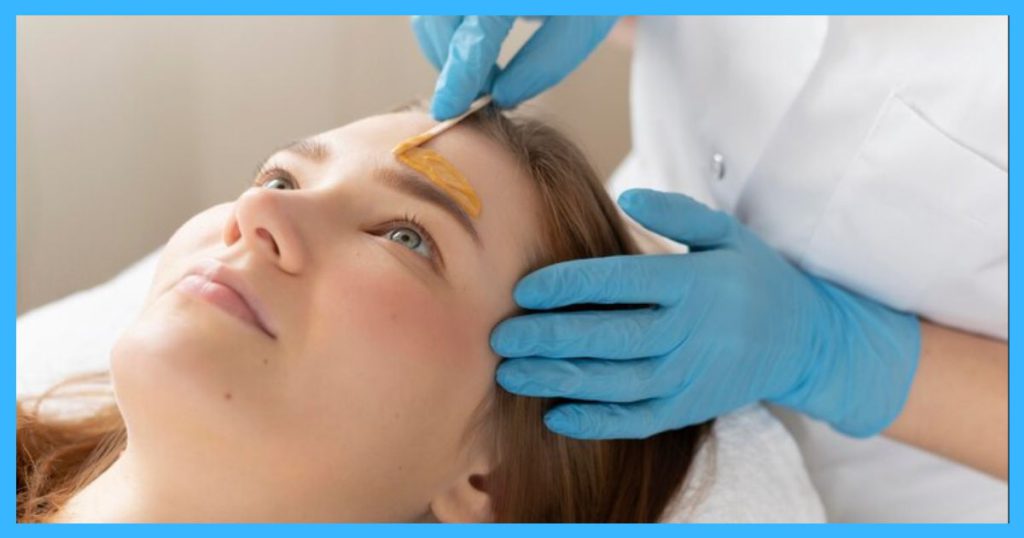
The quick answer is “yes,” but not right away (Already mentioned). As an expert opinion, after getting rid of hair with a laser, your skin needs 1 month to heal from the intense light pulses that hit the hair follicles. Waxing too soon after laser treatment can make the skin even more sensitive, which could cause pain and damage.
Time to Wait Before Waxing
Usually, it would be best if you waited at least one month after your last laser treatment before you think about shaving. Your skin will have plenty of time to heal. The time can change based on the type of skin you have, the area that was treated, and how your skin responds to the laser.
Why Wait?
Laser treatments can make the skin sore and sensitive. This can get worse if you wax too soon. Itl stops hair growth for good by targeting the hair follicles.
However, waxing, which pulls hair out from the root, could make your laser treatments less effective by stopping the follicle from healing properly.
Get Advice From A Professional
It is best to talk to the doctor or technician who did your laser hair removal before deciding whether or not to wax afterwards. They can give you specific advice based on your skin’s response to treatment and your treatment plan.
Risks Associated with Waxing After Laser Hair Removal
Waxing and laser hair removal procedures on the same area of your body include various dangers and considerations. You should be aware of the following:
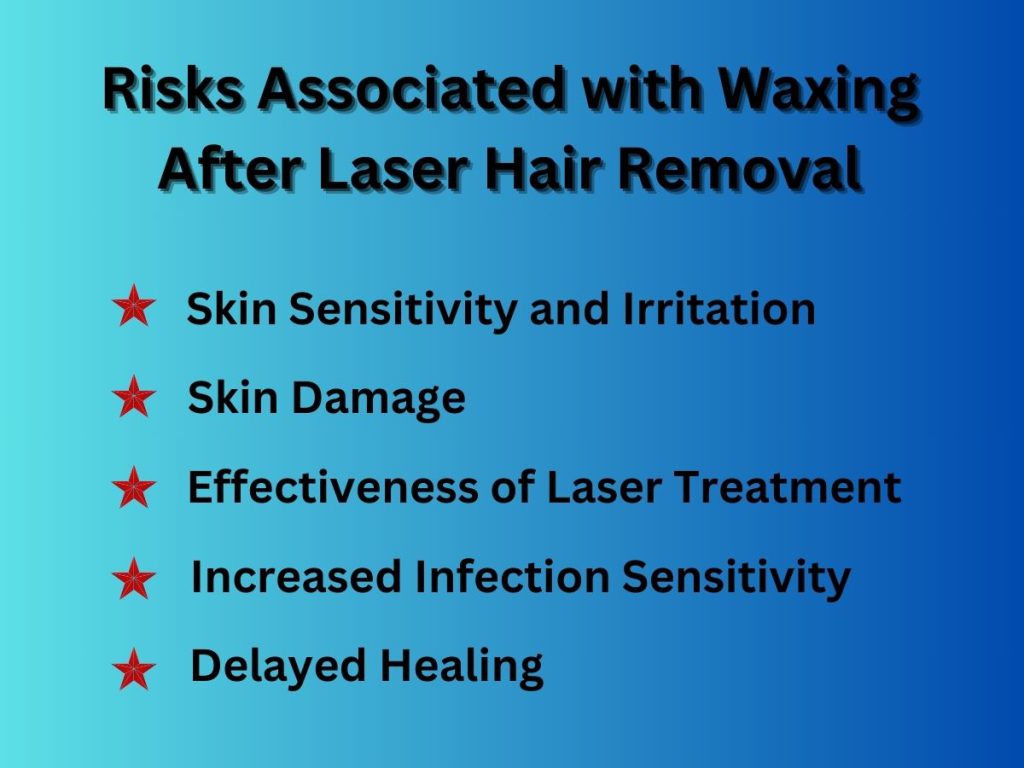
Skin Sensitivity and Irritation: Laser hair removal uses concentrated light to target hair follicles and inhibit hair growth, making skin sensitive. Waxing immediately after laser treatments might irritate the skin, producing redness, swelling, and irritation.
Skin Damage: Waxing removes hair from the root, which can be harsh for freshly laser-treated skin. This can increase the risk of burns, scars, or changes in skin colour, mainly if the skin has not fully recovered from the laser therapy.
Effectiveness of Laser Treatment: Waxing following laser hair removal may interfere with the treatment’s efficiency. Lasers target pigment in hair follicles, while waxing removes hair from the roots, leaving less target for the laser, potentially requiring more sessions.
Increased Infection Sensitivity: Because both treatments can expose and sensitize the skin, bacterial and fungal infections are more likely if necessary precautions are not taken.
Delayed Healing: Combining these treatments can slow the healing process. The skin may take longer to recover, remaining sensitive and vulnerable to irritation for an extended period.
If you are considering both treatments, leaving enough time between waxing and laser treatments is critical. Consulting with a doctor or a professional in cosmetic skin treatments can provide specific advice and help you avoid problems.
Care Tips for Waxing After Laser Hair Removal
Taking extra care of your face is very important after laser hair removal, especially if you plan to wax afterwards.
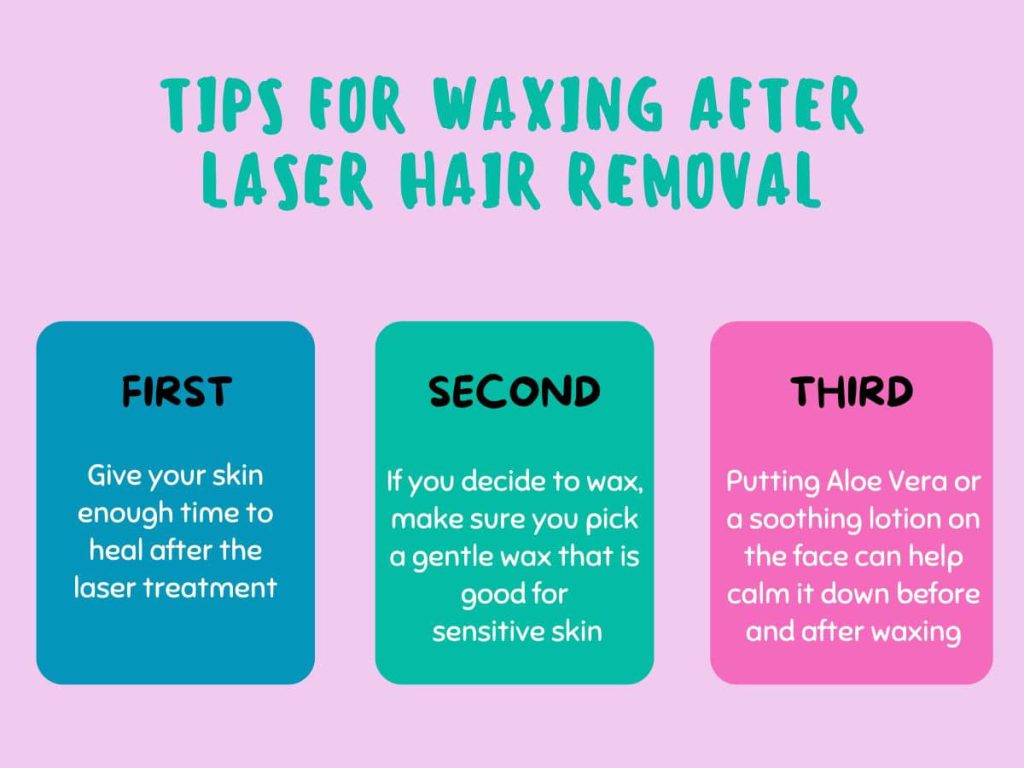
First, give your skin enough time to heal after the laser treatment. Usually, this means waiting at least four weeks before waxing to ensure the skin is fully healed and lower the risk of discomfort.
If you decide to wax, make sure you pick a gentle wax that is good for sensitive skin to keep the damage to a minimum. Cleanse the area gently before waxing to keep any germs that could cause an infection from getting in.
Putting aloe vera or a soothing lotion on the face can help calm it down before and after waxing. If you wax an area, you should only put it in partial sunlight. To protect the skin, use a broad-spectrum sunscreen since it is more likely to get UV damage.
Lastly, keep the area moist and hydrated to help it heal and keep your skin healthy. Talk to a skincare professional immediately if you feel odd pain or see signs of irritation.
Alternatives to Waxing After Laser Hair Removal
If you’ve had laser hair removal and are looking for alternatives to waxing to deal with any new hair growth, there are several gentle and effective choices.
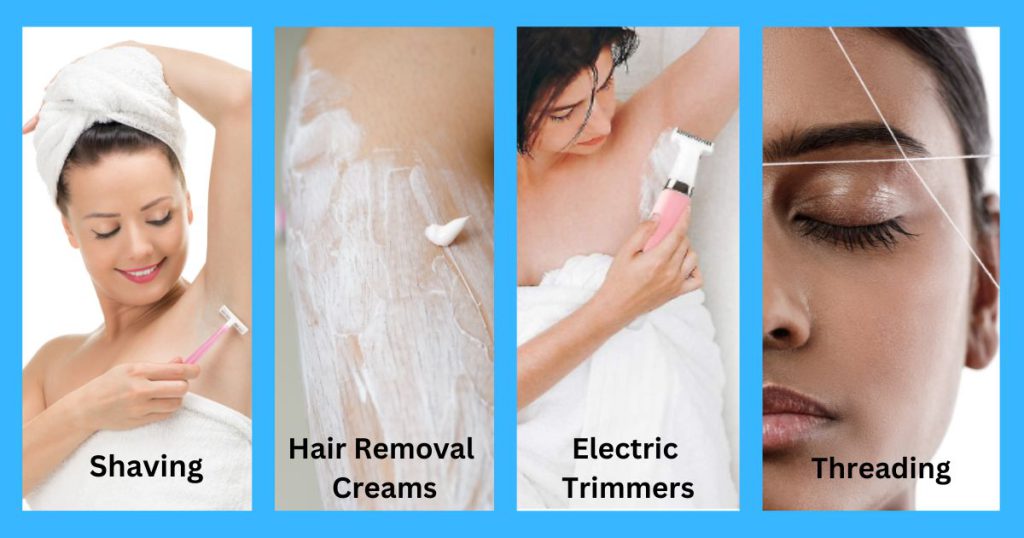
Here are some other options for waxing that can help keep your skin smooth after laser hair removal without making it itch or messing up the effects of your treatments:
-
Shaving
Shaving is one of the easiest options that doesn’t hurt your skin. It only cuts the hair at the skin’s surface, not at the root. This means it won’t pull at the skin or hurt hair cells that are still healing from laser treatments. It’s quick, doesn’t hurt, and can be done at home, so it’s a good choice for people who need a quick fix.
-
Hair Removal Creams
As the name suggests, these creams use chemicals to remove hair just below the skin’s surface. If the chemicals in the product don’t bother your skin, it’s an easy way to do it. Always do a patch test to ensure the cream doesn’t worsen your skin, especially after laser treatment.
-
Electric Trimmers
You can cut your hair with an electric trimmer without pulling it out at the root or scraping the skin. This can be very helpful in sensitive places or if your skin is still sensitive after getting a laser.
They come with different attachments that let you change the amount of hair you want to cut, giving you freedom and control.
-
Threading
Threading is a way to remove hair, which involves twisting a thin thread and pulling on the hair at the root. It’s mostly used for facial hair and is a great choice for people who want accuracy.
Threading doesn’t use any chemicals or products, so it can be suitable for people sensitive to chemicals or wanting a more natural approach.
-
Inhibitors For Natural Hair
You can buy items that claim to slow hair growth. Most of these are made from natural ingredients that slow hair growth over time.
Natural inhibitors can be used with laser hair removal to make the benefits last longer, but they are not actually a way to get rid of hair.
However, Before starting a new hair removal method after laser treatments, always talk to a dermatologist or a laser treatment expert. What they say will depend on your skin type and the details of your laser treatment.
The best way to get rid of hair after laser hair removal relies on how sensitive your skin is, the area you want to treat, and your own personal tastes. All of these alternatives have pros and can work if used properly and with the right safety measures.
Sum Up
Can you wax after laser hair removal? is the common question before starting the treatment. The answer is yes. Waxing after laser hair removal requires careful thought. It’s usually best to wait a while. This helps protect your skin and ensures the laser treatment works well.
Talk to a skincare professional if you’re considering waxing after laser treatments. They can give you the best advice. And if you have any stories or questions, drop them in the comments! We love hearing from you.
And hey, if you found this helpful, why not share it with a friend? They might be curious about it, too.
